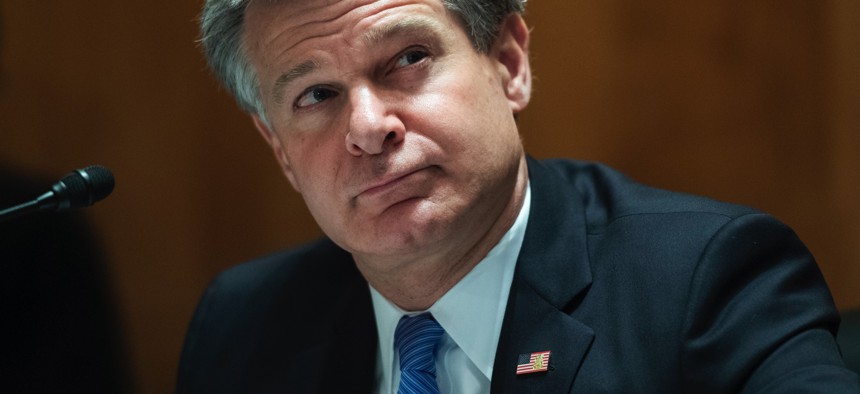
FBI Director Christopher Wray testifies at the Dirksen Senate Office Building in 2020. Tom Williams/CQ-Roll Call, Inc via Getty Images/Pool
Will Americans Buy into Biden’s Ambitious Domestic Terrorism Plan?
The president’s national strategy pivots the United States away from the worst practices of the war on terrorism—if law enforcement, courts, and agencies will follow.
There is much that is notable about the Biden administration’s National Strategy for Countering Domestic Terrorism. Most importantly, it holds the potential of pivoting away from some of the egregious abuses involved in terrorism investigations during the last two decades of the global war on terrorism.
Released in June, the Biden strategy breaks new ground in its deep appreciation of the “complex, multifaceted and evolving” challenge that domestic terrorism poses. It directly and indirectly references the deficiencies of the policies implemented to counter transnational terrorism. And it recognizes that the threat of domestic terrorism—and a mishandled response to it—can threaten democracy. But what precisely is new here, and will it matter?
To start, Biden defines and identifies a wider-array of domestic terrorists, including “racially or ethnically motivated violent extremists [RMVE’s] and networks whose racial, ethnic, or religious hatred leads them toward violence, as well that those whom they encourage to take violent action.” It recognizes gender-motivated violent extremists. It includes “the threat [that] comes from anti–government or anti–authority violent extremists,” and self-proclaimed militias, often representing a wide ideological spectrum. And it lists potentially-violent extremists with topical grievances across the political spectrum, from anti-abortion to animal rights, the environment, and even involuntary celibacy.
Given the many dimensions of domestic extremism, countering the threat is daunting. The internet stands to accelerate recruitment and mobilization of any of these groups. “Gun flows,” including assault weapons, are readily available. And the presence of racially-biased extremists inside the military, law enforcement, and other government agencies pose an additional challenge.
While some critics may claim to see partisan motivations in the administration’s plan, nevertheless, the tone of the strategy emphasizes a methodological approach, a privileging of evidence and procedure, and sense of multiple stakeholders whose various interests need to be adequately addressed.
But there is an important change within this strategy unrelated to recent politics. The Biden plan explicitly promises to diverge from the counterterrorism policies of the war on terror in order to promote constitutional protections. “Past U.S. Government prevention efforts have had a mixed record,” the strategy notes. “We need to do better – better at protecting rights and freedoms while still pursuing the goal of preventing individuals from harming their fellow Americans through terrorism or other criminal activity.”
Towards that end, the strategy repeatedly makes several good-faith efforts at alluding to civil-liberty protections. It distinguishes, for example, between ideology and violence. “Our country and its laws leave wide open the space for political and ideological views and their articulation, including through peaceful protest,” the strategy emphasizes, “But they leave no room for unlawful violence.” Freedom of expression and of assembly are mentioned several times in the report. Wherein civil liberties groups often pointed to the criminalization of speech in the war on terror’s law enforcement investigations, the new strategy, as outlined, intends to focus on acts of violence and inspiring others to acts of violence. As Attorney General Merrick Garland put it when he announced the strategy in June, “we are focused on violence, not on ideology.”
Accordingly, the Biden strategy attempts to define terrorists by their activities, breaking from U.S. policies of the war-on-terror years, during which law enforcement often blanketed Muslims with suspicion, created warrantless surveillance programs, and designed strategies for the aggressive use of informants in FBI stings.
The administration’s strategy also accords respect to privacy protections in the government’s efforts to analyze data from government and private sources. It’s a direct response to criticism of mass warrantless surveillance on American citizens and others within the United States in gross violations of Fourth Amendment protections.
So, what will the Biden administration do to make its plan a reality? The strategy does not actively promote new legislation but instead takes a reflective, wait-and-see approach to whether such legislation is required. For years, discussion of a federal domestic terrorism statute has been at the crosshairs of debate in Washington and beyond. The essence of the debate has been over whether or not the excesses of law enforcement that accompanied prosecutions of suspected international terrorists—for example warrantless surveillance, aggressive FBI stings, and suspicion based on race and ethnicity—will be replicated in a domestic terrorism statute.
While the strategy does not preclude such legislation, it purports to a patient assessment, rather than an aggressive embrace. It aims at “examining carefully what new authorities might be necessary and appropriate…driven by facts and informed by the analysis of experts” who can advise on “both the current authorities for addressing domestic terrorism threats and the implications for civil rights and civil liberties of pursuing any changes to those authorities.”
Biden’s report acknowledges throughout that the threat of domestic extremist violence warrants not just law enforcement actions but a multi-dimension approach involving digital literacy, civic education, and raising public awareness concerning how to effectively combat and prevent domestic terrorism recruitment and mobilization to violence.
All told then, the Biden strategy holds potential. It will be their task to reform practices and policies to achieve that goal. But whether law enforcement, the judicial system, and government agencies tasked with security will ultimately exercise restraint in collecting information, in targeting communities, and in separating speech from action remains to be seen. With judicious and responsible direction from the top, perhaps true regard for civil liberties in the context of terrorism can follow.
Karen J. Greenberg, Ph.D, is director of the Center on National Security at Fordham Law and the author of "Subtle Tools: The Dismantling of American Democracy from the War on Terror to Donald Trump" (Princeton University Press, 2021).
NEXT STORY: Keep Your Eyes on Afghanistan’s ISIS-K




